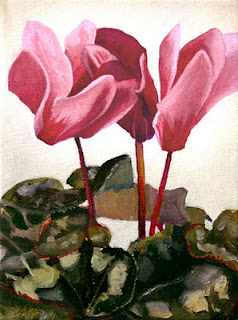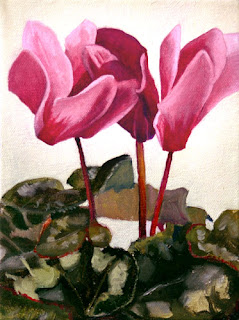

The first version of this cyclamen painting was a bit flat in the flowers and, although not as obvious here, was a bit more orangey than fuscia pink. I painted over the flowers in the first version of the painting with a bright pink glaze. In the shadowy dark areas I mixed in a little permanent blue to the bright pink glaze. By glazing, I didn't have to re-draw any lines or shapes. I simply changed the color. I was happy with the leaves and left those alone.
In this landscape of two islands up north, well, the first version is so bad I even misnamed it. I called it Hawk Island, when in fact it is Crow Island. The painting felt clunky and needed just a little more time to refine, especially the water. So, I went over the entire painting with glazes and some thicker paint here or there. The two biggest changes were to create more contrast in the trees and less contrast in the water. I repainted almost all of the trees and the hillside behind with lighter and darker tones than were there. I also punched up the highlights on the rocks. The end result being that you now see through the tree trunks on the closest island to the furthest island. I also made the leaves on the closer trees more autumnal in order to create even more contrast between them and the island behind.
Then I attacked the water with a scumble of very light blue-grey over the existing wave patterns. This creates more of a surface on the water instead of a pattern. This also creates more distance - as it makes the surface of the water lay down and feel more horizontal.
I never used to go back into paintings once they are completed. But I find it fun when I know that just a few more minutes of tweaking will make a great improvement.






